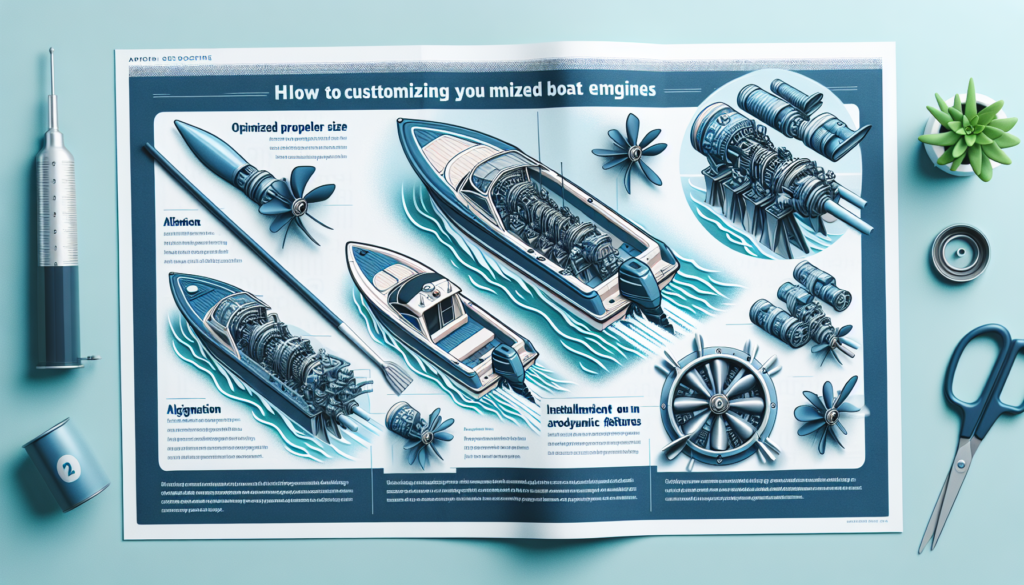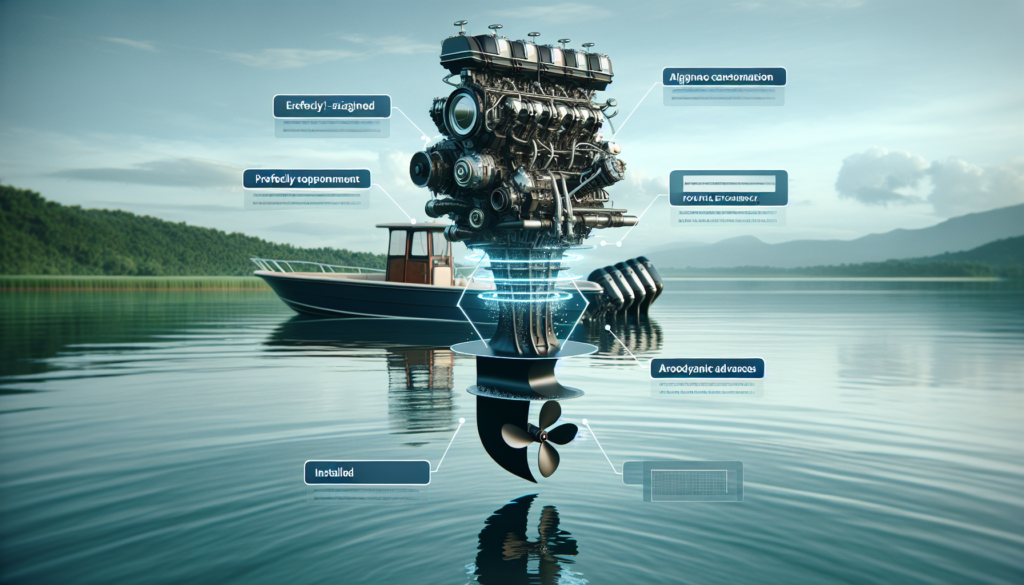Are you tired of spending a fortune on fuel every time you take your boat out for a ride? Well, look no further! In this article, we will show you exactly how you can increase your boat’s fuel efficiency through the power of engine customization. By making a few simple adjustments and tweaks to your boat’s engine, you’ll not only save money on fuel costs but also ensure a smoother, more enjoyable boating experience. So, hop on board and discover the secrets to maximizing your boat’s fuel efficiency right here!
Fuel Efficiency Factors
When it comes to optimizing fuel efficiency in your boat, there are several factors to consider. By focusing on engine type, propeller choice, weight management, hull design, fuel system enhancements, regular maintenance practices, smart navigation techniques, boating practices, and environmental considerations, you can take significant steps towards increasing your fuel efficiency and reducing your fuel consumption. Let’s explore each of these factors in detail.
Engine Type
The engine is undoubtedly the heartbeat of your boat, playing a crucial role in determining its fuel efficiency. When evaluating your existing engine, consider its age, condition, and overall performance. Older engines tend to be less fuel-efficient, so it may be worth exploring options for upgrades or replacements.
One option to consider is diesel engines. Diesel engines are known for their excellent fuel efficiency and longevity. While diesel engines may have a higher upfront cost, they often offer long-term cost savings through reduced fuel consumption. Additionally, diesel engines provide more torque, resulting in better acceleration and the ability to handle heavier loads.
If you’re interested in exploring alternative propulsion options, hybrid systems may be worth considering. Hybrid propulsion systems combine a traditional engine with an electric motor, resulting in reduced fuel consumption and emissions. These systems are particularly useful for lower-speed cruising or when idling in no-wake zones.
Another engine type to consider is the four-stroke outboard engine. Four-stroke outboards are known for their efficiency and reliability. They are generally quieter, emit fewer emissions, and consume less fuel compared to their two-stroke counterparts. Opting for a four-stroke outboard can significantly contribute to your boat’s fuel efficiency.

Propeller Choice
The choice of propeller is another crucial factor in optimizing fuel efficiency. Understanding the basics of propeller design and function will help you make an informed decision.
Firstly, it’s essential to choose the right propeller size for your boat. The propeller must match your boat’s weight, horsepower, and desired performance. A propeller that is too large or too small can lead to inefficient fuel consumption.
Propeller pitch is another critical factor to consider. The pitch refers to the distance a propeller travels forward in one revolution. A higher pitch propeller is better suited for higher speeds, while a lower pitch propeller is ideal for slower speeds. Choosing the right pitch for your boat’s typical cruising speed can improve fuel efficiency.
When it comes to propeller materials, there is a choice between aluminum and stainless steel. While stainless steel propellers offer greater strength and durability, they are also heavier and can have a higher upfront cost. On the other hand, aluminum propellers are lighter and more affordable but may require more frequent replacement. Consider your budget, usage, and durability requirements when deciding between these materials.
Optimizing trim and tilt of your outboard motor can also improve fuel efficiency. Adjusting the position of the motor can reduce drag and resistance, resulting in better fuel consumption. Experiment with different trim and tilt settings to find the most efficient configuration for your boat.
Weight Management
Weight management plays a vital role in fuel efficiency. By reducing unnecessary weight and distributing the load properly, you can maximize your boat’s performance and minimize fuel consumption.
Start by evaluating the equipment and accessories on your boat. Remove any non-essential items that may be adding unnecessary weight. Be mindful of the items you bring on board and consider their necessity for your boating adventures.
Opting for lightweight materials in your boat’s construction is another effective way to manage weight. When purchasing or replacing equipment and accessories, choose lighter alternatives without compromising on quality or safety.
The location of your fuel tank can also impact weight distribution and stability. Placing the fuel tank near the center of the boat and ensuring it’s properly secured can help maintain balance and prevent excessive weight on one side, leading to improved fuel efficiency.
Balancing weight distribution is crucial for optimal performance. Uneven weight distribution can lead to increased drag and resistance, resulting in higher fuel consumption. Properly distribute passenger and cargo loads throughout the boat to maintain balance and minimize fuel wastage.

Hull Design
The design of your boat’s hull can significantly impact fuel efficiency. By evaluating the current hull shape, considering hydrodynamic enhancements, exploring hull modifications, reducing drag, and optimizing the center of gravity, you can achieve better fuel economy.
Start by evaluating your boat’s current hull shape. Different hull designs have varying levels of drag and resistance. Consider consulting with a naval architect or boat designer to determine if your hull shape is optimized for fuel efficiency.
Implementing hydrodynamic enhancements can further improve fuel efficiency. Features such as planing strakes, chines, and reverse chines can reduce drag and increase stabilization, resulting in better overall performance.
If desired, you can explore hull modifications to optimize fuel efficiency. These modifications can include adding hydrofoils or trim tabs, which can further reduce drag and improve stability. However, it’s essential to consult with an expert to ensure that these modifications are suitable for your boat model.
Reducing drag and resistance is key to improved fuel efficiency. Keep the hull clean by regularly cleaning and maintaining it. Remove any unnecessary elements, such as excessive growth, barnacles, or debris, that may increase drag and hinder your boat’s performance.
Optimizing the center of gravity is another consideration. Proper weight distribution, as mentioned earlier, contributes to better fuel efficiency. Position heavy items such as batteries, generators, or water tanks closer to the boat’s center to maintain balance and stability.
Fuel System Enhancements
In addition to engine and propeller choices, enhancing your fuel system can contribute to increased fuel efficiency. Consider the following enhancements to optimize fuel consumption.
Installing fuel flow sensors can provide real-time information about your boat’s fuel consumption. With this data, you can make adjustments to your cruising speed or trim to achieve maximum fuel efficiency.
Fuel additives can also be beneficial in improving fuel efficiency. These additives help to clean deposits, reduce fuel oxidation, and enhance combustion efficiency. Consider using fuel additives that are specifically designed for marine applications and ensure they are compatible with your engine and fuel system.
Upgrading fuel filters is crucial for maintaining proper fuel flow and preventing contaminants from entering the engine. Clean fuel is essential for efficient combustion and optimal performance. Regularly inspect and replace fuel filters as recommended by the manufacturer.
Investing in fuel injection systems can significantly improve fuel efficiency. These systems deliver fuel directly into the engine cylinders at high pressure, resulting in better atomization and combustion. Fuel injection systems provide precise control, reduce fuel wastage, and optimize performance.

Regular Maintenance Practices
Regular maintenance practices are vital for the long-term performance and fuel efficiency of your boat. By keeping your engine properly tuned, changing oil and filters regularly, inspecting the ignition system, maintaining proper propeller alignment, and monitoring the fuel system, you can maximize fuel efficiency while ensuring your boat operates smoothly.
A well-tuned engine runs more efficiently and consumes less fuel. Regularly check and adjust spark plugs, idle speed, throttle linkage, and ignition timing as recommended by the manufacturer. Consider consulting with a professional mechanic or following the manufacturer’s guidelines to ensure proper tuning.
Changing oil and filters at recommended intervals is crucial for engine longevity and performance. Dirty oil and clogged filters can hinder fuel efficiency and increase the risk of engine damage. Follow the manufacturer’s recommendations for oil type and change intervals.
The ignition system is another essential component to inspect. Check spark plug wires, distributor cap, and ignition timing regularly. Faulty ignition components can result in poor combustion, leading to increased fuel consumption. Replace any worn-out components promptly.
Maintaining proper propeller alignment is crucial for smooth operation and fuel efficiency. Misalignment can lead to increased vibrations and unnecessary drag. Regularly inspect the propeller and hub, and adjust or replace them when necessary.
Monitor the fuel system for any signs of leaks, cracks, or blockages. Inspect fuel lines, connections, and fittings regularly. Any issues should be addressed promptly to prevent fuel wastage and potential hazards.
Smart Navigation Techniques
Smart navigation techniques can significantly impact fuel efficiency when cruising in your boat. By optimizing your cruising speed, avoiding excessive idling, utilizing trim tabs, taking advantage of currents and tides, and avoiding overloading the boat, you can minimize fuel consumption.
Optimizing your cruising speed is key to fuel efficiency. Find the sweet spot where your boat operates most efficiently. Usually, this is a speed just under the point where the bow starts to rise significantly. Experiment with different speeds and RPMs to find the most fuel-efficient range for your boat.
Avoid excessive idling whenever possible. Idling consumes fuel without propelling the boat forward. If you need to pause or wait, consider shutting off the engine to conserve fuel. However, be aware of safety considerations and local regulations when turning off the engine.
Trim tabs can improve fuel efficiency by reducing drag and improving your boat’s stability. Adjusting the trim tabs can help level the boat, especially in uneven water conditions. Properly adjusted trim tabs can optimize performance and fuel consumption.
Take advantage of currents and tides when planning your routes. By utilizing favorable currents and tides, you can save fuel by reducing the effort required to move through the water. Consider consulting tide charts and current forecasts when planning your boating trips.
Avoid overloading your boat with excessive cargo or passengers. Overloading can negatively impact fuel efficiency and overall performance. Ensure you stay within the recommended weight limits for your boat and distribute the load evenly to maintain balance and stability.

Boating Practices
When it comes to fuel efficiency, your boating practices can have a significant impact. By planning efficient routes, reducing unnecessary stops, avoiding operating at maximum speed, monitoring and adjusting trim, and minimizing wake generation, you can optimize fuel consumption.
Planning your routes efficiently can help reduce overall travel distance and fuel consumption. Take into account factors such as navigation markers, potential obstacles, and traffic patterns when charting your course. Use GPS or navigational charts to plan the most direct and fuel-efficient routes.
Reduce unnecessary stops during your boating trips. Frequent stops and starts consume more fuel compared to consistent cruising. Plan your itinerary to minimize stops, refueling, or docking, whenever possible.
Avoid operating your boat at maximum speeds continuously. While it may be tempting to unleash the full horsepower of your engine, higher speeds significantly increase fuel consumption. Instead, find the optimal speed range, as discussed earlier, and cruise comfortably within that range.
Monitor and adjust trim while underway. Factors such as weight distribution or changing water conditions can affect your boat’s trim. Properly adjust the trim to minimize drag and enhance fuel efficiency. Pay attention to how your boat responds to different trim settings and make adjustments accordingly.
Minimize wake generation whenever possible. Large wakes not only increase fuel consumption but can also have adverse effects on the environment and other boaters. Be considerate of your surroundings and operate at speeds and distances that minimize wake size and disturbance.
Environmental Considerations
As responsible boaters, it’s essential to consider the environmental impact of our actions. By choosing ethanol-free fuel, disposing of oil and waste properly, avoiding fuel spills, and supporting eco-friendly boating initiatives, we can minimize our carbon footprint and protect our waterways.
Choosing ethanol-free fuel is a conscious choice to reduce environmental impact. Ethanol can be harmful to marine engines and fuel systems, reducing performance and fuel efficiency. Look for ethanol-free fuel options and consider their availability and compatibility with your engine.
Dispose of oil and waste properly to prevent contamination of our waterways. Never dump oil, fuel, or other hazardous substances into the water. Collect used oil and dispose of it at designated facilities. Ensure waste materials are safely disposed of according to local regulations.
Avoid fuel spills when refueling your boat. Spilled fuel can harm aquatic life and pollute our waterways. Use spill-proof fuel containers and be attentive while refueling to prevent spills. If any spills occur, clean them up promptly and properly to minimize environmental impact.
Support eco-friendly boating initiatives in your local community. Participate in cleanup events, follow best practices for environmental stewardship, and stay informed about local regulations and conservation efforts. By working together, we can protect and preserve our waterways for future generations.
In conclusion, increasing fuel efficiency with Boat Engine Customization involves considering various factors and implementing specific practices. By evaluating engine type, making the right choices for propellers, managing weight properly, optimizing hull design, enhancing the fuel system, practicing regular maintenance, implementing smart navigation techniques, adopting fuel-friendly boating practices, and prioritizing environmental considerations, you can achieve significant improvements in fuel efficiency. By taking these steps, you not only save money on fuel costs but also contribute to a cleaner, more sustainable boating experience. So, get out there, enjoy the water, and make a positive impact on the environment!



